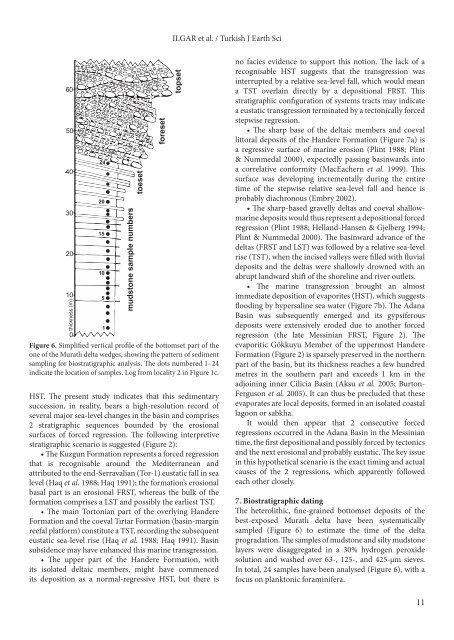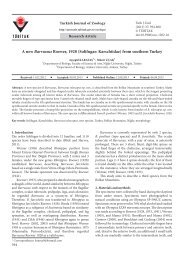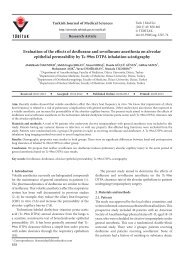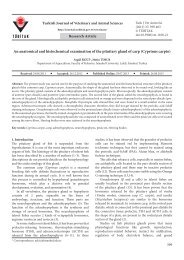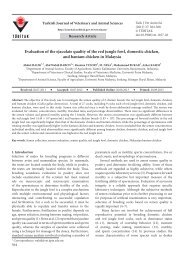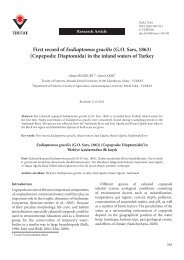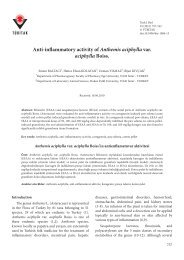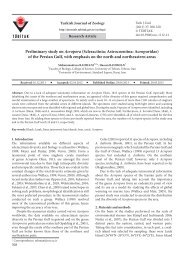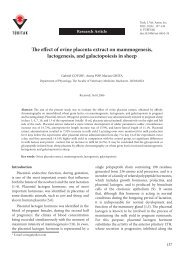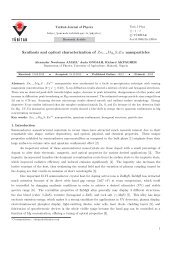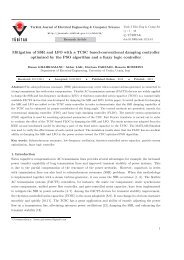Messinian forced regressions in the Adana Basin: a near ... - Tübitak
Messinian forced regressions in the Adana Basin: a near ... - Tübitak
Messinian forced regressions in the Adana Basin: a near ... - Tübitak
You also want an ePaper? Increase the reach of your titles
YUMPU automatically turns print PDFs into web optimized ePapers that Google loves.
Figure 6. Simplified vertical profile of <strong>the</strong> bottomset part of <strong>the</strong><br />
one of <strong>the</strong> Muratlı delta wedges, show<strong>in</strong>g <strong>the</strong> pattern of sediment<br />
sampl<strong>in</strong>g for biostratigraphic analysis. The dots numbered 1–24<br />
<strong>in</strong>dicate <strong>the</strong> location of samples. Log from locality 2 <strong>in</strong> Figure 1c.<br />
HST. The present study <strong>in</strong>dicates that this sedimentary<br />
succession, <strong>in</strong> reality, bears a high-resolution record of<br />
several major sea-level changes <strong>in</strong> <strong>the</strong> bas<strong>in</strong> and comprises<br />
2 stratigraphic sequences bounded by <strong>the</strong> erosional<br />
surfaces of <strong>forced</strong> regression. The follow<strong>in</strong>g <strong>in</strong>terpretive<br />
stratigraphic scenario is suggested (Figure 2):<br />
• The Kuzgun Formation represents a <strong>forced</strong> regression<br />
that is recognisable around <strong>the</strong> Mediterranean and<br />
attributed to <strong>the</strong> end-Serravalian (Tor-1) eustatic fall <strong>in</strong> sea<br />
level (Haq et al. 1988; Haq 1991); <strong>the</strong> formation’s erosional<br />
basal part is an erosional FRST, whereas <strong>the</strong> bulk of <strong>the</strong><br />
formation comprises a LST and possibly <strong>the</strong> earliest TST.<br />
• The ma<strong>in</strong> Tortonian part of <strong>the</strong> overly<strong>in</strong>g Handere<br />
Formation and <strong>the</strong> coeval Tırtar Formation (bas<strong>in</strong>-marg<strong>in</strong><br />
reefal platform) constitute a TST, record<strong>in</strong>g <strong>the</strong> subsequent<br />
eustatic sea-level rise (Haq et al. 1988; Haq 1991). Bas<strong>in</strong><br />
subsidence may have enhanced this mar<strong>in</strong>e transgression.<br />
• The upper part of <strong>the</strong> Handere Formation, with<br />
its isolated deltaic members, might have commenced<br />
its deposition as a normal-regressive HST, but <strong>the</strong>re is<br />
ILGAR et al. / Turkish J Earth Sci<br />
no facies evidence to support this notion. The lack of a<br />
recognisable HST suggests that <strong>the</strong> transgression was<br />
<strong>in</strong>terrupted by a relative sea-level fall, which would mean<br />
a TST overla<strong>in</strong> directly by a depositional FRST. This<br />
stratigraphic configuration of systems tracts may <strong>in</strong>dicate<br />
a eustatic transgression term<strong>in</strong>ated by a tectonically <strong>forced</strong><br />
stepwise regression.<br />
• The sharp base of <strong>the</strong> deltaic members and coeval<br />
littoral deposits of <strong>the</strong> Handere Formation (Figure 7a) is<br />
a regressive surface of mar<strong>in</strong>e erosion (Pl<strong>in</strong>t 1988; Pl<strong>in</strong>t<br />
& Nummedal 2000), expectedly pass<strong>in</strong>g bas<strong>in</strong>wards <strong>in</strong>to<br />
a correlative conformity (MacEachern et al. 1999). This<br />
surface was develop<strong>in</strong>g <strong>in</strong>crementally dur<strong>in</strong>g <strong>the</strong> entire<br />
time of <strong>the</strong> stepwise relative sea-level fall and hence is<br />
probably diachronous (Embry 2002).<br />
• The sharp-based gravelly deltas and coeval shallowmar<strong>in</strong>e<br />
deposits would thus represent a depositional <strong>forced</strong><br />
regression (Pl<strong>in</strong>t 1988; Helland-Hansen & Gjelberg 1994;<br />
Pl<strong>in</strong>t & Nummedal 2000). The bas<strong>in</strong>ward advance of <strong>the</strong><br />
deltas (FRST and LST) was followed by a relative sea-level<br />
rise (TST), when <strong>the</strong> <strong>in</strong>cised valleys were filled with fluvial<br />
deposits and <strong>the</strong> deltas were shallowly drowned with an<br />
abrupt landward shift of <strong>the</strong> shorel<strong>in</strong>e and river outlets.<br />
• The mar<strong>in</strong>e transgression brought an almost<br />
immediate deposition of evaporites (HST), which suggests<br />
flood<strong>in</strong>g by hypersal<strong>in</strong>e sea water (Figure 7b). The <strong>Adana</strong><br />
Bas<strong>in</strong> was subsequently emerged and its gypsiferous<br />
deposits were extensively eroded due to ano<strong>the</strong>r <strong>forced</strong><br />
regression (<strong>the</strong> late <strong>Mess<strong>in</strong>ian</strong> FRST, Figure 2). The<br />
evaporitic Gökkuyu Member of <strong>the</strong> uppermost Handere<br />
Formation (Figure 2) is sparsely preserved <strong>in</strong> <strong>the</strong> nor<strong>the</strong>rn<br />
part of <strong>the</strong> bas<strong>in</strong>, but its thickness reaches a few hundred<br />
metres <strong>in</strong> <strong>the</strong> sou<strong>the</strong>rn part and exceeds 1 km <strong>in</strong> <strong>the</strong><br />
adjo<strong>in</strong><strong>in</strong>g <strong>in</strong>ner Cilicia Bas<strong>in</strong> (Aksu et al. 2005; Burton-<br />
Ferguson et al. 2005). It can thus be precluded that <strong>the</strong>se<br />
evaporates are local deposits, formed <strong>in</strong> an isolated coastal<br />
lagoon or sabkha.<br />
It would <strong>the</strong>n appear that 2 consecutive <strong>forced</strong><br />
<strong>regressions</strong> occurred <strong>in</strong> <strong>the</strong> <strong>Adana</strong> Bas<strong>in</strong> <strong>in</strong> <strong>the</strong> <strong>Mess<strong>in</strong>ian</strong><br />
time, <strong>the</strong> first depositional and possibly <strong>forced</strong> by tectonics<br />
and <strong>the</strong> next erosional and probably eustatic. The key issue<br />
<strong>in</strong> this hypo<strong>the</strong>tical scenario is <strong>the</strong> exact tim<strong>in</strong>g and actual<br />
causes of <strong>the</strong> 2 <strong>regressions</strong>, which apparently followed<br />
each o<strong>the</strong>r closely.<br />
7. Biostratigraphic dat<strong>in</strong>g<br />
The heterolithic, f<strong>in</strong>e-gra<strong>in</strong>ed bottomset deposits of <strong>the</strong><br />
best-exposed Muratlı delta have been systematically<br />
sampled (Figure 6) to estimate <strong>the</strong> time of <strong>the</strong> delta<br />
progradation. The samples of mudstone and silty mudstone<br />
layers were disaggregated <strong>in</strong> a 30% hydrogen peroxide<br />
solution and washed over 63-, 125-, and 425-µm sieves.<br />
In total, 24 samples have been analysed (Figure 6), with a<br />
focus on planktonic foram<strong>in</strong>ifera.<br />
11


